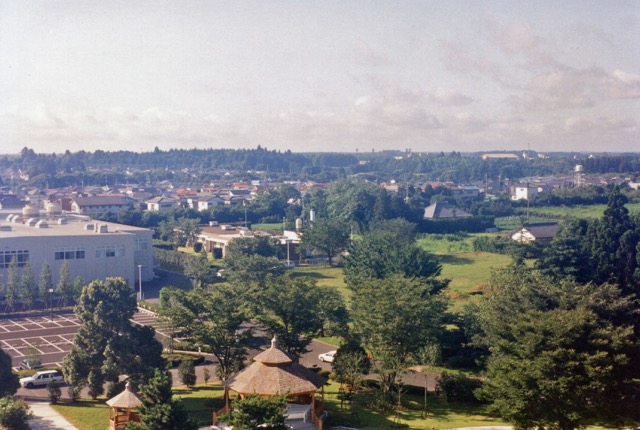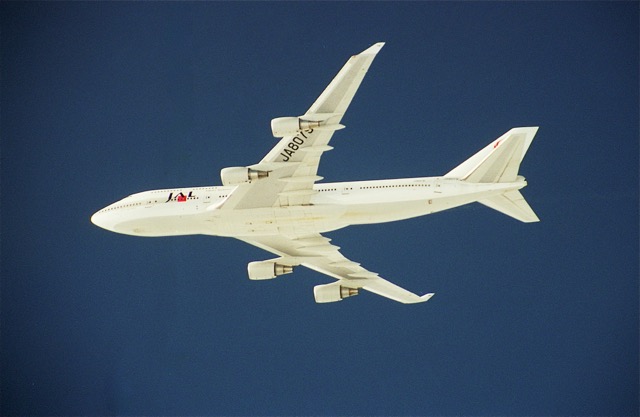I was thrilled when Kathy McCullough accepted my request to share some of her experiences working in her very special office. As a former Northwest Orient Airlines pilot who worked her way up to the mythical position of captain of a Boeing 747, Kathy paints a very vivid picture of how it feels to be an airline pilot. This article focuses primarily, but not only, on Kathy’s experiences in Japan. I can only recommend Karlene Petit’s post for a more detailed introduction to Kathy’s path as a pilot.
______________________________________________________________________________
Kathy McCullough: My first flight as a crewmember on an airliner was out of Minneapolis. I was ecstatic to be a new 727 flight engineer and the first day, I remember some of the baggage handlers were driving mail trains and ran into each other watching me. I laughed, realizing they rarely saw women pilots.
The whole experience was surreal, and I even had a dream one night that I was preflighting the wrong plane in the fog, and my captain from the Forest Service had to lead me back over to my 727!

When I first started flying for NW Airlines in 1981, I flew only domestic flights within the United States and Canada. People stopped in their tracks and stared when they saw a female pilot. One lady asked her husband, “Is that a woman pilot?” The man answered loudly, “Of course she is. Where have you been, Doris? Locked in a closet all these years?” I felt sorry for her!
Women would congratulate me as they left the plane, telling their daughters, “Look, she’s flying the plane! You can be a pilot if you want to!” Men would stop at the cockpit door to tell me they flew, too, and then give me tips on how to improve my landing, even if it was the captain’s landing.
Muhammad Ali was traveling First Class with us one day, and he was both shocked and worried when I came out of the cockpit. Muhammad said, “Now I am scared!” That was an eye opener for me, and I told him I didn’t think he was afraid of anything.
Flying famous people around was always fun. Karate Kid’s Mr. Miyagi (Pat Morita) asked me if he could use the bathrooms on the ground. He probably thought I was the lead flight attendant! Ed McMann, a pilot himself, offered to fly the plane with me if the other pilot didn’t show up.
The first time I had to go back in a Boeing 727 to check and see if the landing gear was down and locked, the captain made an announcement that I would be coming through the cabin. That didn’t stop eighteen passengers from asking me for drinks along the way. I finally had to get rude and do my job, ripping up the carpet to check the red alignment stripes painted beneath a small glass window mid-cabin.
Flying in the Orient was always an experience

Women pilots were even less common in Japan. In fact, Japan Airlines (JAL) didn’t have any. Numerous times we let Japanese men off the plane before flight when they found out a lady was in the cockpit. One day we were deadheading from Singapore back to Narita, in uniform, on JAL and asked if we could say hello to the pilots (professional courtesy). The flight attendants told us they would escort us up during cruise, when the pilots were less busy. We were surprised because the FAA would never allow us to have passengers in the cockpit during the flight.
When they escorted us, we went up to the cockpit and talked to the pilots for half an hour. Our captain asked if they had any women pilots. The JAL captain said: “No, never!” quite firmly. He must have realized how he came across because he clarified his statement. “Me, I would much rather have her sitting next to me than his ugly face. But JAL, Never!” We got a good laugh out of that, although his copilot wasn’t laughing, and in 1995 JAL did train their first female pilot.

We used to joke about the route we had to fly into Narita. It never varied. Japanese controllers are very rigid. You knew exactly what speed to slow to, what heading to fly, and how many miles out before our turn. After years of repetition and hundreds of flights, one night, out of the blue, a Japanese controller told us we were cleared for a visual approach. We didn’t believe him and had to confirm. “Cleared for the visual? You mean we can turn now?”
“Yes, Northwest Sixty-Eight, cleared for the visual. Make your turn wherever you wish.”
Wow! Freedom!
(Mis)communications
Emergencies were a nightmare when I first started flying to Japan in 1988. It took forever to get an ambulance to the airplane, and that was after the agonizing descent and landing with little way to communicate the severity or what you needed. Heart attack they (maybe) understood, but nothing more complicated.
We were not given landing clearance into Japan in a “first come, first served” order like we do in the United States, either. If there were All Nippon Airways (ANA) or JAL planes arriving, they were put in front of us. This was frustrating because we had to watch our fuel, especially after long flights from the United States. Once, when we were in holding and getting close to our decision fuel time, I asked for our “sequence,” common terminology in the Air Traffic Control world. The controller acted like he didn’t understand me, but I knew he did. He refused to answer. I persisted, saying we needed to know, and he asked if we had an emergency. I said no, but we would have to go to our alternate if they didn’t give us an ETA. (ETA’s, or estimated time of arrival, are a necessary part of the clearance, but frequently they are missing in Japanese clearances.) Instead, he gave us a heading to fly toward the airport, but still put two newly arrived Japanese planes in front of us!

We knew that any “emergencies” of ours ended up on the front page of the Japanese papers with warnings and propaganda on why you should only fly JAL or Al Nippon! Even little things, like declaring low fuel when they were holding us up or having a blown tire, were the top news story if NW Airlines was involved. Yet when one of their carriers had a problem you heard and saw nothing on the news.
Extreme winds
The closest I ever came to dying was on a flight to Narita, Japan, but it had nothing to do with their controllers. The winds were strong and gusty, with wind shear reported in the area. On final approach, the captain was having trouble controlling the plane. The flight engineer and I were calling out airspeeds and altitudes. It got violent and scary. We told the captain to go around. He wouldn’t.
The airplane in front of us reported severe wind shear and decided not to land. They requested vectors to Haneda, Tokyo’s other airport. Narita International was effectively closed down. Silently the engineer and I cheered. We were going to Haneda, too! The captain had other ideas. We had enough kerosene to go into a holding pattern and wait for the winds to die down. The flight engineer and I protested, to no avail. The captain promised us that if it was still bad on the next approach, we would go to our alternate airport. Twenty minutes later, we tried again.
It seemed impossible, but it was worse than before. The plane was thrown around the sky like a toy boat on the ocean. Encountering wind shear close to the ground, we told him to go around. I started to push the power up, but the captain shook his head and pushed my hand away. Short of committing mutiny, there was nothing I could do. At two hundred feet above the ground, the plane rolled sideways, out of control. I looked out my window at the pavement below. I knew I was dead. We would cartwheel and burn, just like a friend of mine had died on a Learjet. I hoped it would be quick, and said a silent prayer and goodbye to my family.
Miraculously, the plane righted itself and the captain squeaked the plane onto the runway. A perfect touchdown! The passengers cheered. The engineer and I were furious and knew that it was luck or God that saved us. The captain was apologetic, but claimed he knew what he was doing. Bullshit. We taxied to the gate. We were the only plane that landed in Narita that afternoon.
Twenty-seven other flights diverted to Haneda. We reported the captain to Professional Standards. Instead of being in trouble, the captain, S/O and I received letters of commendation for the landing. Unbelievable.
The engineer quit the airline to live out his days on his boat. I pondered what else I could have done. To this day I am convinced the engineer and I should have been more forceful, but I know we wouldn’t have a job if we had pushed the issue.
(…)
This is the end of Part I. I would like to thank again Kathy for sending me her stories.
If you liked this story, follow me on Twitter @thefullgull !
There is a podcast by Marvin Robinson about Kathy’s career on the inspiredpilot website:
Kathy McCullough – Retired Boeing 747 Captain, Photographer & Pilot Mentor